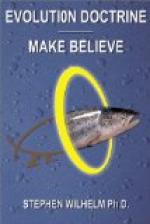* * * * *
Embryology as a distinct division of zooelogy has grown out of studies of classification and comparative anatomy. Its beginnings may be found in medieval natural history, for as far back as 1651 Harvey had pointed out that all living things originate from somewhat similar germs, the terse dictum being “Ex ovo omnia.” By the end of the eighteenth century many had turned to the study of developing organisms, though their views by no means agreed as to the way an adult was related to the egg. Some, like Bonnet, held that the germ was a minute and complete replica of its parent, which simply unfolded and enlarged like a bud to produce a similar organism. Even if this were true, little would be gained, for it would still remain unknown how the germinal miniature originated to be just what it was conceived and assumed to be. Wolff was the originator of the view that is now practically universal among naturalists, namely, that development is a real process of transformation from simpler to more complex conditions.
The subject of comparative embryology grew rapidly during the nineteenth century as the field of comparative anatomy became better known, and when naturalists became interested in animals, not only as specific types, but also as the finished products of an intricate series of transformations. When life-histories were more closely compared, the meaning of the resemblances between early stages of diverse adult organisms was read by the same method which in comparative anatomy finds that consanguinity is expressed by resemblance. The great law of recapitulation, stated in one form by Von Baer and more definitely by Haeckel in the terms employed in the foregoing sections, was for a time too freely used and too rigidly applied by naturalists whose enthusiasm clouded their judgment. A strong reaction set in during the latter part of the nineteenth century, when attention was directed to the anachronisms of the embryonic record and to the alterations that are the results of larval or embryonic adaptation as short cuts in development. Nevertheless, it is not seriously questioned, I believe, that the main facts of a single life-history owe their nature to the past evolution of the species to which a given animal belongs.




